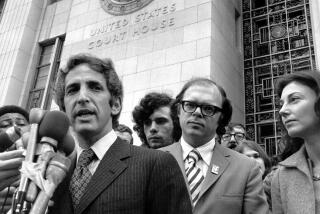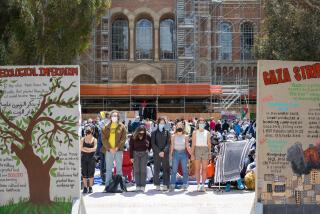20 Years After Nixon’s Resignation, Scandal Still Intrigues U.S. : Watergate: White House called break-in at Democratic headquarters “a third-rate burglary,” but it brought down the President and his men.
- Share via
WASHINGTON — At one end of the Watergate exhibit in the Richard Nixon Library and Birthplace, a wall-sized photo mural speaks volumes about the most famous resignation in history. It shows Nixon as he boarded the helicopter that took him into exile, arms outstretched in his trademark victory salute and an incongruous smile on his face.
On Tuesday, it will be 20 years since that tense Friday when Nixon ended two years of scheming to preserve his presidency. He went to his grave last April, never groveling, as he put it, having conceded only the mistakes of not setting a high enough standard for the people who worked for him.
“I should have established a moral tone that would have made such actions unthinkable,” Nixon said. “I did not. I played by the rules of politics as I found them. . . . For that reason, I long ago accepted overall responsibility for the Watergate affair.”
He dismissed Watergate as “one part wrongdoing, one part blundering, and one part political vendetta,” and as “a tragedy of errors.” His resignation was simply “one major defeat in a career that involved both victories and losses, both peaks and valleys.”
Of those who were not satisfied--and there were many--Nixon said, “If they want me to get down and grovel on the floor, no. Never.”
On Aug. 8, 1974, in a television speech announcing his resignation effective at noon the next day, Nixon told the American people: “I have never been a quitter. To leave office before my term is completed is opposed to every instinct in my body. But as President I must put the interests of America first.”
That was both truth and evasion. Truth: The country was mesmerized and numbed by the biggest political scandal in its history and the government was paralyzed. Evasion: Nixon left because the hot wind of certain impeachment made his survival impossible.
He recalled the moment of departure as “a frame of film forever frozen”--someone waving a white handkerchief from the window of the Lincoln bedroom, the flag on top of the White House hanging limp “in the windless, cheerless morning,” the noise of the chopper’s engines that grew until it blotted out thought, Pat Nixon saying to no one in particular, “It’s so sad. It’s so sad.”
Twenty years have passed. Other government scandals have come and gone, as they always do, but none had the staying power of Watergate.
Tourists still flock to the Watergate complex to be photographed where it began. The story is retold regularly in new books; the Library of Congress lists 222 titles that include the word “Watergate,” and there are hundreds more about the scandal that don’t. For example: John Dean’s “Blind Ambition,” H. R. Haldeman’s “Haldeman Diaries,” Judge John Sirica’s “To Set the Record Straight.”
The Nixon Library in Yorba Linda, Calif., where the anniversary is scarcely a cause for celebration, has scheduled “a firsthand account of RN’s last 28 days at the White House from a man who was there,” Nixon aide Frank Gannon.
A five-part television series on the Discovery Channel revisits Watergate by allowing some of the chief players, including John Ehrlichman, Haldeman and Dean to spin the tale once again with the perspective of history.
The extraordinary Nixon interviews with David Frost are being shown again, as fresh today as they were in 1977, when Nixon insisted, “I did not, in my view, commit an impeachable offense.”
And love him or hate him, 3 1/2 months after his death, Richard Nixon continues to fascinate Americans. One measure is the number of visitors to his grave, 55 feet from his birthplace in Yorba Linda. The Nixon Library says it expects nearly a million people by the end of the year.
“Nixon was a large figure. He had large ambitions; he had intense hatreds,” Leonard Garment, Nixon’s White House Watergate lawyer, said at a Discovery Channel symposium in connection with its series.
“He had tremendous flaws. His presidency and, in a sense, Watergate, was a way in which he could exorcise the tremendous demons of hatred that had accumulated over the years and which he, himself, had been both the perpetrator and the recipient of an immense amount of political abuse.”
Those are the words of a friend. Others are less kind.
“Nothing happened that Richard Nixon didn’t OK, nothing, and it’s preposterous to think that anything of the magnitude of a break-in of the Democratic National Committee headquarters didn’t come from Richard Nixon,” said Alexander Butterfield, a top Nixon White House aide who disclosed the existence of a taping system. “Preposterous. It could not happen. I would stake my life on that.”
Nixon’s slide to disaster began after midnight on June 17, 1972, when five men were arrested in the Democratic Party headquarters on the 6th floor of the Watergate office building.
It was, in White House terms, “a third-rate burglary,” but it held more serious terrors for the President’s men. A year before, four of the burglars had helped ransack the office of the Beverly Hills psychiatrist treating Daniel Ellsberg; the fifth was a former CIA agent working for Nixon’s reelection committee.
The trail quickly led to the leaders of the burglary team, G. Gordon Liddy and E. Howard Hunt, who had been hired by the White House to trace leaks of sensitive information--thus the name, White House plumbers--and who were in charge of political intelligence for the Committee to Reelect the President, or CREEP.
If Nixon had disavowed their actions, cut them loose, his involvement would have ended there. Instead, he approved steps to divert an FBI investigation for fear that their actions in the Ellsberg break-in would become known. Ellsberg had leaked the Pentagon Papers, a study of the origins of the Vietnam War.
From that inauspicious start began Nixon’s inexorable march to disgrace.
The cast was staggering. John Mitchell--Nixon’s friend, former law partner and attorney general--had discussed the burglary and given it his OK; top aide Charles Colson was implicated in pushing for intelligence; Haldeman and Ehrlichman, Nixon’s top assistants, were involved in the cover-up. So was Dean, his counsel. All were among the 11 Nixon people who served time in prison.
Nixon, named by a federal grand jury as one of 18 unindicted co-conspirators, did not. He received “a full, free and absolute pardon” from his successor, President Gerald R. Ford.
“Next to the resignation,” Nixon said, “accepting the pardon was the most painful decision of my political career.”
More to Read
Sign up for Essential California
The most important California stories and recommendations in your inbox every morning.
You may occasionally receive promotional content from the Los Angeles Times.













